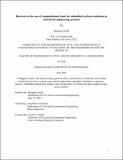Barriers to the use of computational tools for embodied carbon reduction in structural engineering practice
Author(s)
Smith, Margaret
DownloadThesis PDF (4.397Mb)
Advisor
Carstensen, Josephine
Terms of use
Metadata
Show full item recordAbstract
There is an immediate need to decrease carbon emissions to minimize the impacts of climate change, and building materials, which in 2019 accounted for 10% of global carbon emissions, have an important role to play in this reduction. As key stakeholders in the building design process, structural engineers must implement strategies to reduce embodied carbon. One strategy is using less material, and in academia, many methods and tools have been proposed to reduce embodied carbon through material efficiency. This includes parametric models that demonstrate how structural parameters impact embodied carbon and shape or topology optimized components which save considerable amounts of material compared to conventional alternatives. However, these tools are not used often in industry. To better understand why, a survey was distributed to practicing structural engineers in the northeast US which probed their views on embodied carbon and computational tools to reduce it. Case studies on parametric design, shape optimization, and topology optimization were presented, and participants were asked if they would use each tool and why or why not.
A total of 38 structural engineers, representing 26 different employers, responded to the survey. Most respondents could name a strategy to reduce embodied carbon, however, low-carbon materials were mentioned far more than using less material, indicating that there is a need for increased education on the power of material efficiency to impact embodied carbon. As expected, respondents were most willing to use parametric design, followed by shape optimization, then topology optimization. For all case studies, time and/or cost increase was identified as the strongest barriers to their use. For parametric design, lack of power during the design process was also a strong barrier, as structural engineers often do not have complete control over all structural parameters. For shape and topology optimization, constructability and the robustness of optimized designs were key concerns. By formalizing the barriers to their use, this work enables researchers to create computational tools that are more likely to be adopted in industry. These tools have great potential to decrease embodied carbon emissions, and for this to be realized, they must be put into practice.
Date issued
2023-06Department
Massachusetts Institute of Technology. Department of Civil and Environmental EngineeringPublisher
Massachusetts Institute of Technology